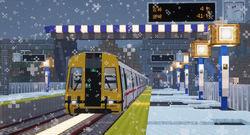Keio Line
Views
Actions
Namespaces
Variants
Tools
| Status | Operational |
|---|---|
| Owner | Kowloon-Canton_Railway_Corporation |
| Locale | Joban |
| Termini | Iwaki Hatchōbori |
| Stations | 5 |
| Initials | KL |
| Operator(s) | Kowloon-Canton_Railway_Corporation |
|---|---|
| Depot(s) | Aki Depot |
| Rolling stock | KCR EMU |
| Former Rolling Stock | KCRC_K-Stock KCRC_M-Train |
| Opened | 16th June 1909 |
|---|
| Line Length | 15km (9.32mil) |
|---|---|
| Track gauge | 1435mm |
| Electrification | 25Kv |
| Operating speed | 120km/h |
The Keio Line (Chinese: 京王線) is a rail line operated by the Kowloon-Canton Railway, running from Iwaki to Hatchōbori, and is the second line built by KCRC.
History
Freight era
While the Joestu Line was being built, Kintetsu would also build a freight line of 15km north of Iwaki to connect with Hatchōbori which was then a big village that offered many goods and many foreign companies set up camp at, therefore it was decided that the freight line would be built to compete with rival truck companies. The line was single tracked and freight trains ran up until the early 80s, acting as additional income for Kintetsu and KCRC (after 1943)
Conversion to passenger rail line
However things took a sharp turn in the mid-70s when many of the industrial areas closed and soon were taken into development, with crowded and infrequent buses, the need of a rail line would soon be apparent to the government, who approached KCRC to electrify and convert the line into a passenger line, after 2 years of rebuilding and electrification, the Keio Line would be fully electrified and use the same trains from the Joestu Line. The last freight trains would run in 1985 and the line from then on would only see passenger trains.
Future
Ever since the late 2000s, the line hasn't been touched and facilities have since shown their age, KCRC has planned for a refurbishment of the line which will see the retirement of the currently running KCR EMU Trains with the introduction of a new EMU train that will bring a more comfortable service to commuters. Stations have already began their refurbishment such as Hatchōbori.
Stations
Not completed
Rolling Stock
All trains run as 4 car units
- KCR EMU (Since 16th March 1985)
